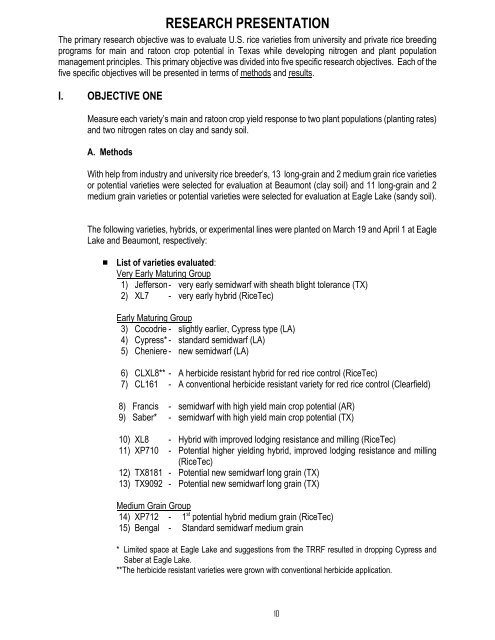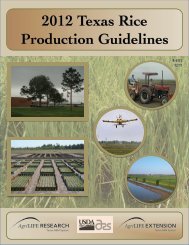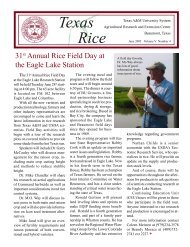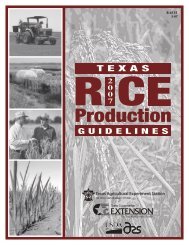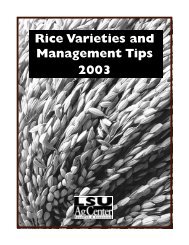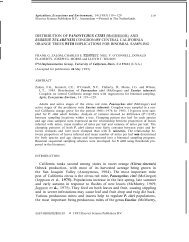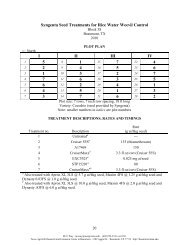Evaluating Potential Rice Varieties from University and Industry ...
Evaluating Potential Rice Varieties from University and Industry ...
Evaluating Potential Rice Varieties from University and Industry ...
Create successful ePaper yourself
Turn your PDF publications into a flip-book with our unique Google optimized e-Paper software.
RESEARCH PRESENTATION<br />
The primary research objective was to evaluate U.S. rice varieties <strong>from</strong> university <strong>and</strong> private rice breeding<br />
programs for main <strong>and</strong> ratoon crop potential in Texas while developing nitrogen <strong>and</strong> plant population<br />
management principles. This primary objective was divided into five specific research objectives. Each of the<br />
five specific objectives will be presented in terms of methods <strong>and</strong> results.<br />
I. OBJECTIVE ONE<br />
Measure each variety’s main <strong>and</strong> ratoon crop yield response to two plant populations (planting rates)<br />
<strong>and</strong> two nitrogen rates on clay <strong>and</strong> s<strong>and</strong>y soil.<br />
A. Methods<br />
With help <strong>from</strong> industry <strong>and</strong> university rice breeder’s, 13 long-grain <strong>and</strong> 2 medium grain rice varieties<br />
or potential varieties were selected for evaluation at Beaumont (clay soil) <strong>and</strong> 11 long-grain <strong>and</strong> 2<br />
medium grain varieties or potential varieties were selected for evaluation at Eagle Lake (s<strong>and</strong>y soil).<br />
The following varieties, hybrids, or experimental lines were planted on March 19 <strong>and</strong> April 1 at Eagle<br />
Lake <strong>and</strong> Beaumont, respectively:<br />
# List of varieties evaluated:<br />
Very Early Maturing Group<br />
1) Jefferson- very early semidwarf with sheath blight tolerance (TX)<br />
2) XL7 - very early hybrid (<strong>Rice</strong>Tec)<br />
Early Maturing Group<br />
3) Cocodrie - slightly earlier, Cypress type (LA)<br />
4) Cypress* - st<strong>and</strong>ard semidwarf (LA)<br />
5) Cheniere - new semidwarf (LA)<br />
6) CLXL8** -<br />
7) CL161 -<br />
8) Francis -<br />
9) Saber* -<br />
10) XL8 -<br />
11) XP710 -<br />
12) TX8181 -<br />
13) TX9092 -<br />
A herbicide resistant hybrid for red rice control (<strong>Rice</strong>Tec)<br />
A conventional herbicide resistant variety for red rice control (Clearfield)<br />
semidwarf with high yield main crop potential (AR)<br />
semidwarf with high yield main crop potential (TX)<br />
Hybrid with improved lodging resistance <strong>and</strong> milling (<strong>Rice</strong>Tec)<br />
<strong>Potential</strong> higher yielding hybrid, improved lodging resistance <strong>and</strong> milling<br />
(<strong>Rice</strong>Tec)<br />
<strong>Potential</strong> new semidwarf long grain (TX)<br />
<strong>Potential</strong> new semidwarf long grain (TX)<br />
Medium Grain Group<br />
14) XP712 - 1 st potential hybrid medium grain (<strong>Rice</strong>Tec)<br />
15) Bengal - St<strong>and</strong>ard semidwarf medium grain<br />
* Limited space at Eagle Lake <strong>and</strong> suggestions <strong>from</strong> the TRRF resulted in dropping Cypress <strong>and</strong><br />
Saber at Eagle Lake.<br />
**The herbicide resistant varieties were grown with conventional herbicide application.<br />
10


